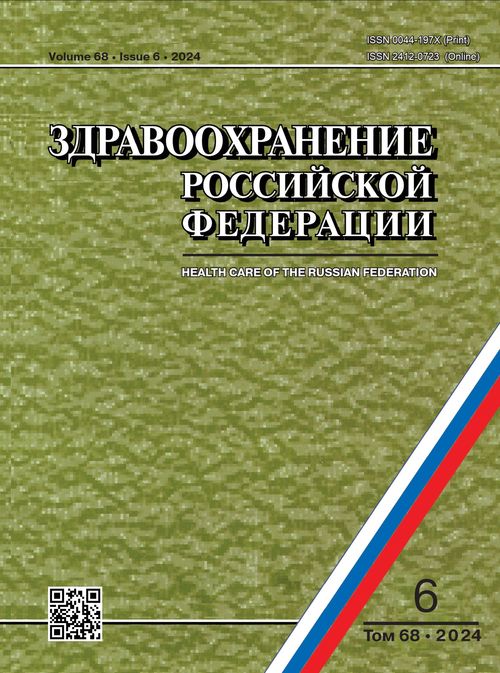Особенности генетического профиля детей с дорсопатией, осложнённой дорсалгией, в условиях контаминации биосред свинцом
- Авторы: Отавина Е.А.1, Долгих О.В.1
-
Учреждения:
- ФБУН «Федеральный научный центр медико-профилактических технологий управления рисками здоровью населения» Федеральной службы по надзору в сфере защиты прав потребителей и благополучия человека
- Выпуск: Том 68, № 6 (2024)
- Страницы: 500-504
- Раздел: АКТУАЛЬНЫЕ ВОПРОСЫ ГИГИЕНЫ
- Статья получена: 14.01.2025
- URL: https://hum-ecol.ru/0044-197X/article/view/646182
- DOI: https://doi.org/10.47470/0044-197X-2024-68-6-500-504
- EDN: https://elibrary.ru/utpacf
- ID: 646182
Цитировать
Полный текст
Аннотация
Введение. Большая распространённость патологий костно-мышечной системы у детей, в частности дорсопатий, осложнённых болевым синдромом — дорсалгией, является одной из ведущих проблем здравоохранения. Значительный вклад в формирование патологии вносит загрязнение окружающей среды тяжёлыми металлами. Свинец — наиболее распространённый и опасный из промышленных токсикантов, оказывает негативный эффект на незрелую костную и нервную систему детей, патологии в которых, оставаясь без должного внимания, в будущем сказываются на качестве жизни и работоспособности.
Цель исследования — оценка особенностей однонуклеотидных замен гена метионин синтазы (MTR) и рецептора дофамина (DRD2) у школьников с дорсопатией, осложнённой дорсалгией, в условиях контаминации биосред свинцом.
Материалы и методы. В исследовании участвовали 78 школьников в возрасте 7–11 лет с дорсопатией, проживающих в условиях промышленно развитого региона. Группа наблюдения (n = 26) отличалась от группы сравнения (n = 52) наличием дорсалгии. Исследовано содержание свинца в крови методом масс-спектрометрии с индуктивно связанной плазмой. Полиморфные варианты генов DRD2 (rs1800497) и MTR (rs1805087) идентифицированы методом полимеразной цепной реакции в режиме реального времени.
Результаты. Школьники, проявления дорсопатии у которых сочетались с явлениями дорсалгии, характеризуются повышенным относительно фонового уровня и значений группы сравнения содержанием свинца в крови, повышенной частотностью T-аллеля гена рецептора дофамина DRD2 (rs1800497), G-аллеля и AG генотипа гена метионин синтазы MTR (rs1805087), а также избыточным уровнем дофамина и ионизированного кальция.
Ограничения исследования. Использование небольшого объёма выборки.
Заключение. Особенности полиморфизма кандидатных генов DRD2 (rs1800497) и MTR (rs1805087) у детей с дорсопатией и синдромом дорсалгии сопряжены с нарушением процессов детоксикации, целостности и плотности костной ткани и обусловливают риск (относительный риск 1,73–1,77; 95% доверительный интервал 1,23–2,53) возникновения патологии костно-мышечной системы, сопровождающейся контаминацией биосред свинцом, изменениями показателей гомеостаза, модифицирующих развитие данной патологии.
Соблюдение этических стандартов. Исследование одобрено этическим комитетом ФБУН «ФНЦ МПТ УРЗН» (протокол № 11 от 14.03.2023). Все участники дали информированное добровольное письменное согласие на участие в исследовании.
Участие авторов:
Отавина Е.А. — сбор и обработка материала, статистическая обработка, написание и редактирование текста;
Долгих О.В. — концепция, дизайн исследования, редактирование, ответственность за целостность всех частей статьи.
Все соавторы — утверждение окончательного варианта статьи, ответственность за целостность всех частей статьи.
Финансирование. Исследование не имело спонсорской поддержки.
Конфликт интересов. Авторы декларируют отсутствие явных и потенциальных конфликтов интересов в связи с публикацией данной статьи.
Поступила 04.04.2024 / Принята к печати 03.10.2024 / Опубликована 28.12.2024
Ключевые слова
Об авторах
Елена Алексеевна Отавина
ФБУН «Федеральный научный центр медико-профилактических технологий управления рисками здоровью населения» Федеральной службы по надзору в сфере защиты прав потребителей и благополучия человека
Email: eleninca@mail.ru
ORCID iD: 0000-0002-6173-6017
Мл. науч. сотр. отдела иммунобиологических методов диагностики ФБУН «ФНЦ медико-профилактических технологий управления рисками здоровью населения» Роспотребнадзора, 614045, Пермь, Россия
e-mail: eleninca@mail.ru
Олег Владимирович Долгих
ФБУН «Федеральный научный центр медико-профилактических технологий управления рисками здоровью населения» Федеральной службы по надзору в сфере защиты прав потребителей и благополучия человека
Автор, ответственный за переписку.
Email: oleg@fcrisk.ru
ORCID iD: 0000-0003-4860-3145
Доктор мед. наук, профессор, зав. отделом иммунобиологических методов диагностики ФБУН «ФНЦ медико-профилактических технологий управления рисками здоровью населения» Роспотребнадзора, 614045, Пермь, Россия
e-mail: oleg@fcrisk.ru
Список литературы
- Покатилов А.Б., Новак А.П., Сарванова С.В., Ярошенко И.П. О тревожных тенденциях роста заболеваемости костно-мышечной системы у детей и подростков и перспективах их профилактики. Главный врач Юга России. 2020; (1): 19–22. https://elibrary.ru/nptjqu
- Олейникова Т.А., Пожидаева Д.Н., Орешко А.Ю. Мониторинг заболеваемости патологиями костно-мышечной системы и соединительной ткани в Российской Федерации. Фармакоэкономика. Современная фармакоэкономика и фармакоэпидемиология. 2019; 12(1): 5–13. https://doi.org/10.17749/2070-4909.2019.12.1.5-13 https://elibrary.ru/cyzxcb
- Хитров Н.А. Возрастные аспекты дорсопатий. Consilium Medicum. 2015; 17(9): 97–102. https://elibrary.ru/uqbnbd
- Мансурова Г.Ш., Мальцев С.В., Рябчиков И.В. Особенности формирования опорно-двигательной системы у школьников: заболевания, причины и возможные пути коррекции. Практическая медицина. 2019; 17(5): 51–5. https://doi.org/10.32000/2072-1757-2019-5-51-55 https://elibrary.ru/kfyxcj
- Ахполова В.О., Брин В.Б. Обмен кальция и его гормональная регуляция. Журнал фундаментальной медицины и биологии. 2017; (2): 38–46. https://elibrary.ru/zhrgch
- Мансурова Г.Ш., Мальцев С.В., Рябчиков И.В. Оценка уровня обеспеченности кальцием детей с патологией опорно-двигательного аппарата. Практическая медицина. 2018; (2): 52–6. https://elibrary.ru/yxorqw
- Кадникова Е.П. Химическое загрязнение среды обитания и состояние здоровья детей дошкольного возраста, по данным социально-гигиенического мониторинга. Здоровье населения и среда обитания – ЗНиСО. 2019; (2): 9–14. https://doi.org/10.35627/2219-5238/2019-311-2-9-14 https://elibrary.ru/kjlgvf
- Ахполова В.О., Брин В.Б. Современные представления о кинетике и патогенезе токсического воздействия тяжелых металлов (обзор литературы). Вестник новых медицинских технологий. 2020; 27(1): 55–61. https://doi.org/10.24411/1609-2163-2020-16578 https://elibrary.ru/krwvgs
- Кабдрахманова Г.Б., Утепкалиева А.П. О роли экотоксикантов в развитии нейротоксикозов. Медицинский журнал Западного Казахстана. 2018; (1): 29–36. https://elibrary.ru/xnkckd
- Vorvolakos T., Arseniou S., Samakouri M. There is no safe threshold for lead exposure: Α literature review. Psychiatriki. 2016; 27(3): 204–14. https://doi.org/10.22365/jpsych.2016.273.204
- Chiang T.I., Lane H.Y., Lin C.H. D2 dopamine receptor gene (DRD2) Taq1A (rs1800497) affects bone density. Sci. Rep. 2020; 10(1): 13236. https://doi.org/10.1038/s41598-020-70262-0
- Saito M., Marumo K. The effects of homocysteine on the skeleton. Curr. Osteoporos. Rep. 2018; 16(5): 554–60. https://doi.org/10.1007/s11914-018-0469-1
- Гальченко А.В. Влияние факторов образа жизни на метаболизм костной ткани и риск развития остеопороза. Профилактическая медицина. 2022; 25(6): 96–107. https://doi.org/10.17116/profmed20222506196 https://elibrary.ru/wehqhj
- Ledda C., Cannizzaro E., Lovreglio P., Vitale E., Stufano A., Montana A., et al. Exposure to toxic heavy metals can influence homocysteine metabolism? Antioxidants (Basel). 2019; 9(1): 30. https://doi.org: 10.3390/antiox9010030
- Puopolo M. The hypothalamic-spinal dopaminergic system: a target for pain modulation. Neural. Regen. Res. 2019; 14(6): 925–30. https://doi.org/10.4103/1673-5374.250567
- Мирзоев Э.Б., Кобялко В.О., Полякова И.В., Губина О.А. Метаболизм свинца и механизмы его цитотоксического действия в организме млекопитающих (обзор). Сельскохозяйственная биология. 2018; 53(6): 1131–41. https://doi.org/10.15389/agrobiology.2018.6.1131rus https://elibrary.ru/yyfqhb
Дополнительные файлы









